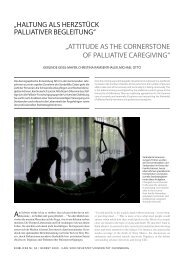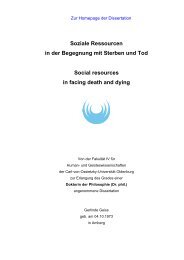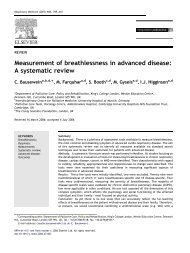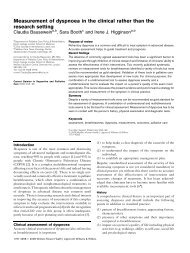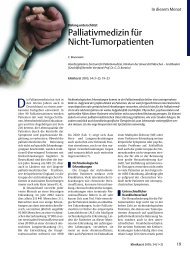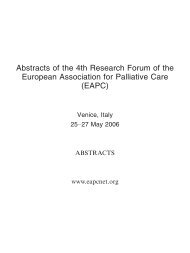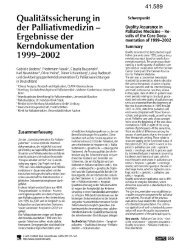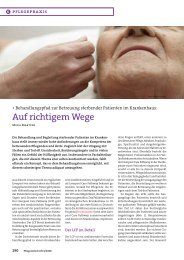EAPC - ipac
EAPC - ipac
EAPC - ipac
You also want an ePaper? Increase the reach of your titles
YUMPU automatically turns print PDFs into web optimized ePapers that Google loves.
400 <strong>EAPC</strong> Abstracts<br />
In addition to the support that <strong>EAPC</strong> provides with these projects for the<br />
advocacy work of national palliative care associations and for health care<br />
professionals in palliative care <strong>EAPC</strong> needs to raise the support of the<br />
institutions of the European treaties, the Council of Europe, the European<br />
Commission and the European Parlament to secure the future of palliative<br />
care in Europe. The development of palliative care needs a strong and<br />
ongoing commitment from decision makers in the European institutions<br />
and other national or European stakeholders!<br />
3 Invited Lecture<br />
Plenary Session 1<br />
Translational pain research – From molecular biology to the clinic<br />
Authors: Frank Skorpen Head of Molecular Biology Section of Pain and<br />
Palliation Research Group, Faculty of Medicine, Norwegian University of<br />
Science and Technology NORWAY<br />
The aim of this lecture is to give an overview of the current evidence for a<br />
relationship between polymorphisms in human genes and variability in opioid<br />
analgesia and side effects among patients treated for moderate or severe<br />
pain. Participants will learn how new knowledge from molecular biology<br />
and genetics can help us understand how the individual’s genotype affects<br />
the outcome of opioid treatment. They will also learn about challenges and<br />
opportunities for genetic research in palliative care, and what have to be<br />
overcome before “genetic profiling” can be used as a supplementary tool<br />
for decision-making in the treatment of severe pain. Control of pain and<br />
related symptoms is paramount to clinical success in caring for patients<br />
with advanced cancer and other terminal illnesses. Opioids are the mainstay<br />
of therapy for moderate to severe cancer pain at the end of life, with oral<br />
morphine being recommended by the World Health Organization and the<br />
European Association for Palliative Care as the conventional opioid of<br />
choice. However, in spite of expert recommendations, careful dose escalation<br />
and “optimization” of the management regime, successful opioid treatment<br />
is not attained in a substantial minority of patients. Unpleasant side<br />
effects are usually inevitable, and although side effects may be controllable,<br />
they can not easily be predicted. The integration of molecular genetics<br />
approaches into the study of complex health phenomena is an increasingly<br />
important and available strategy for researchers across the health science<br />
disciplines. In recent years, research investigating the relationship between<br />
the genetic variability among individuals and susceptibility to disease, clinical<br />
symptoms or treatment responses has grown exponentially. With an<br />
estimated number of at least ten millions, single nucleotide polymorphisms<br />
(SNPs) account for about 90% of all molecular differences in the human<br />
DNA sequence. Although many SNPs have no effect on cell function, others<br />
can have a major impact on how humans respond to disease, environmental<br />
exposures, drugs and other therapies, including sensitivity to opioid<br />
therapy. For example, polymorphisms in the µ-opioid receptor gene<br />
(OPRM1) are primary candidate sources of clinical variability in opioid<br />
therapy. Powerful analytical tools now make it possible to screen patients<br />
for their allelic status at very high resolution. However, for genetic information<br />
to be clinically useful, the genotype to phenotype correlations need to<br />
be based on properly measured and well defined end points. The lack of<br />
international standards for the assessment of subjective symptoms and classification<br />
of patients stands out as a major obstacle for the translation of<br />
genetic research into real opioid therapy improvements in palliative care.<br />
4 Plenary presentation<br />
Plenary Session 1<br />
Paying to Die: The Economic Burden of Care Faced by Patients<br />
and Their Caregivers<br />
Authors: Konrad Fassbender Department of Oncology, Health Services<br />
Centre University of Alberta, Grey Nuns Community Hospital CANADA<br />
Carolina Aguilar Department of Clinical Epidemiology & Biostatistics,<br />
McMaster University, Hamilton CANADA<br />
Carleen Brenneis Regional Palliative Care Program, Capital Health<br />
Edmonton CANADA<br />
Robin Fainsinger Department of Oncology, University of Alberta<br />
Edmonton CANADA<br />
Background: Palliative care programs require participation of non-paid caregivers.<br />
The economic burden associated with this paradigm shift however is<br />
unknown. Methods: Prospective questionnaire measuring health care<br />
resource utilization by adult palliative care patients (prognosis between 2 and<br />
24 weeks) between Feb 2004 and June 2007, in Canada. Primary caregivers<br />
were interviewed at baseline and every two weeks thereafter. Resource use,<br />
out-of-pocket expenses and time related losses were measured and valued<br />
according to established guidelines for economic evaluation. Results: A total<br />
of 301 caregiver-patient diads comprised 13.0% of the eligible palliative care<br />
population. Patients averaged 66.2 years of age, of which 55.1% were male.<br />
On average, patients were followed for 64.6 days at baseline (mean=34.3min)<br />
and interviewed a further 2.74 times (mean=8.8min). Patients received care<br />
from an average 1.82 individuals (max=7) providing a total of 91.6hrs of care<br />
per week (or 64.9hrs/caregiver/week). Caregivers’ non-work activities were<br />
severely limited: 69.3% reduction in time spent performing domestic work,<br />
46.3% personal care and 73.2% leisure. More than half of caregivers participated<br />
in the workforce: employed (35.0%) or temporarily absent from their<br />
work (19.5%). One in seven patients (14.3%) receives care from at least one<br />
caregiver experiencing work losses (mean = 17.3 hrs/wk/patient). Assuming<br />
an average wage rate of $23.90 (16.18 EUR), caregiver time related losses are<br />
estimated at $40,329 (27 302 EUR) per patient and exceed the direct medical<br />
and out of-pocket costs. Discussion: Time related costs attributable to the care<br />
of each dying patient are equivalent to the annual wages of a caregiver and<br />
therefore impose a significant burden to families and employers. Inadequate<br />
financial support of dying patients and their families by governments will<br />
jeopardize both the health and economic benefits associated with the continued<br />
growth of palliative care programs.<br />
5 Plenary presentation<br />
Plenary Session 1<br />
Use of advance directives in dementia: the patient’s perspective<br />
Authors: Marike E. de Boer Department of Nursing Home Medicine<br />
Institute for Research in Extramural Medicine NETHERLANDS<br />
Cees Jonker Institute for Research in Extramural Medicine, VU University<br />
Medical Centre Amsterdam NETHERLANDS<br />
Rose-Marie Dröes Department of Psychiatry/Alzheimer Centre, VU<br />
University Medical Centre Amsterdam NETHERLANDS<br />
Cees M.P.M. Hertogh Institute for Research in Extramural Medicine, VU<br />
University Medical Centre Amsterdam NETHERLANDS<br />
Jan A. Eefsting Institute for Research in Extramural Medicine, VU<br />
University Medical Centre Amsterdam NETHERLANDS<br />
Background: Advance directives enable people to manage their future by<br />
expressing their wishes with regard to (end-of-life) care. It is generally<br />
assumed that, if diagnosed in the early stages, people with dementia still<br />
have the necessary capacities to write an advance directive. However, it is<br />
never explored what people with (early) dementia think and expect of the<br />
future and what their views are on advance care planning. Methods: In depth<br />
interviews among elderly people with early stage Alzheimer’s disease (AD)<br />
(n=24) and additional interviews with partners/proxies (n=24) were carried<br />
out and analysed, following the principles of grounded theory. Results:<br />
Results show that most elderly people with (early) AD tend to live by the day<br />
and refrain from thinking about the future. Only a few mention that disclosure<br />
of the diagnosis and information on advance directives, causes them to<br />
start thinking about the future and advance care planning. Those that already<br />
had an advance directive prior to the diagnosis are often not aware of the<br />
existence of the document and its content, which makes it difficult to elicit<br />
their views. Conclusions: Our findings raise questions regarding the relevance<br />
given to advance directives by people with early AD. If advance directives<br />
are considered of importance for people with dementia to exercise their<br />
right to self-determination with regard to advance care planning their



